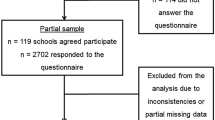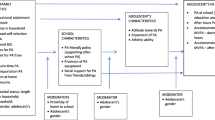Abstract
Purpose
To identify patterns of school environment and association with physical activity (PA) in different domains
Methods
Cross-sectional data from the National School Health Survey (2015) was used, and students enrolled in the ninth grade of elementary education were evaluated. Electronic questionnaires were answered by students and the school principal. The study outcomes were PA indicators (yes/no): commuting; Physical Education; leisure-time; reaching PA guidelines. The exposure was related to the school environment (physical, social and political factors). Sociodemographic characteristics were described using proportions and mean with standard deviations. Principal Components Analysis (PCA) was used to identify environmental school-related patterns. Multilevel binary logistic regression models were applied.
Results
81,154 students with a mean age of 14.3 ± 1.3 years old were investigated. Most of the students reported participating in Physical Education (80.8%), but only 8.6% of them met PA guidelines. The PCA revealed five patterns that explained 53% of the variance among the environmental school characteristics. Higher scores of both Sports Courts and Sports & Materials patterns were associated with a higher odds of participation in Physical Education (OR: 1.27 and 1.13, respectively). Higher scores for the Open Schools pattern increased the odds of PA in commuting to school (OR: 1.12), leisure-time PA (OR: 1.03), and met PA guidelines (OR:1.04); Higher scores for Track & Pool pattern increased the practice of Physical Education (OR: 1.05).
Conclusion
The findings reinforce the role of the school environment within PA and reveal a complex association, as different patterns of the school environment may favor specific PA domains more than others. The promotion of PA must consider the multiple layers of the school environment to enhance PA practice across all domains.
Similar content being viewed by others
References
Bull FC, Al-Ansari SS, Biddle S et al (2020) World Health Organization 2020 guidelines on physical activity and sedentary behaviour. Br J Sports Med 54:1451–1462
Sallis JF, Cervero RB, Ascher W et al (2006) An ecological approach to creating active living communities. Annu Rev Public Health 27:297–322
Morton K, Atkin A, Corder K et al (2016) The school environment and adolescent physical activity and sedentary behaviour: a mixed-studies systematic review. Obes Rev 17:142–158
Brasil. Ministério da Saúde (2021) Secretaria de Atenção Primária à Saúde. Departamento de Promoção da Saúde. Guia de Atividade Física para a População Brasileira [recurso eletrônico]. Brasília: Ministério da Saúde.
World Health Organization (2018) Global action plan on physical activity 2018–2030: more active people for a healthier world. World Health Organization, Geneva
Carlin A, Perchoux C, Puggina A et al (2017) A life course examination of the physical environmental determinants of physical activity behaviour: A “Determinants of Diet and Physical Activity” (DEDIPAC) umbrella systematic literature review. PLoS ONE 12:e0182083
Harrison F, Jones AP (2012) A framework for understanding school based physical environmental influences on childhood obesity. Health Place 18:639–648
Martins J, Marques A, Sarmento H et al (2015) Adolescents’ perspectives on the barriers and facilitators of physical activity: a systematic review of qualitative studies. Health Educ Res 30:742–755
Knuth A, Hallal P (2012) School environment and physical activity in children and adolescents: systematic review. Rev Bras Ativ Fis Saúde 17:463–473
de Rezende LFM, Azeredo CM, Silva KS et al (2015) The role of school environment in physical activity among Brazilian adolescents. PLoS ONE 10:e0131342
Turner K, Foster C, Allender S et al (2015) A systematic review of how researchers characterize the school environment in determining its effect on student obesity. BMC Obes 2:13
Sallis JF, Owen N (1997) Ecological models. Health Educ Behav 2:403–424
Ganzar LA, Ranjit N, Saxton D et al (2019) Association of school physical activity policies with student physical activity behavior. J Phys Act Health 16:340–347
Woods CB, Volf K, Kelly L et al (2021) The evidence for the impact of policy on physical activity outcomes within the school setting: a systematic review. J Sport Health Sci 10:263–276
Whitehead Margareth. Definition of physical literacy and clarification of related issues. ICSSPE Bulletim; 65.
de Oliveira MM, Campos MO, de Andreazzi MAR et al (2017) Characteristics of the National adolescent school-based health survey-PeNSE Brazil. Epidemiologia e Serviços de Saúde 26:605–616
BRASIL (2021) Instituto Nacional de Estudos e Pesquisas, Educacionais Anísio Teixeira (Inep). Resumo Técnico: Censo Escolar da Educação Básica 2021. Brasilia, DF: Inep
Guedes DP, Lopes CC (2010) Validação da versão brasileira do youth risk behavior survey 2007. Rev Saude Publica 44:840–850
Pesquisa Nacional de Saúde do Escolar - PENSE 2015. Rio de Janeiro, RJ: IBGE, https://biblioteca.ibge.gov.br/visualizacao/livros/liv97870.pdf (2016, accessed 23 July 2019).
Brasil. Ministério da Saúde. Secretaria de Atenção à Saúde. Departamento de Atenção Básica. Passo a passo PSE : Programa Saúde na Escola : tecendo caminhos da intersetorialidade.
Pessoa P dos S, Klumpp CFB, Fernandes J da SG, et al. Programa mais educação: revisão de literatura. Psicologia da Educação 2017; 87–94.
Daniel Abud Seabra Matos, Erica Castilho Rodrigues (2019) Análise Fatorial. Brasília: Enap
Knuth A, Silva I, Hallal P (2015) Description of the school environment related to physical education classes, recess, extracurricular activities and physical spaces in the city of Pelotas, RS, Brazil. Revista Brasileira de Atividade Física & Saúde 20:524–524
Nichol ME, Pickett W, Janssen I (2009) Associations Between School Recreational Environments and Physical Activity. J Sch Health 79:247–254
Swinburn B, Kraak V, Rutter H et al (2015) Strengthening of accountability systems to create healthy food environments and reduce global obesity. The Lancet 385:2534–2545
Gomes TN, dos Santos FK, Zhu W et al (2014) Multilevel analyses of school and children’s characteristics associated with physical activity. J School Health 84:668–676
Zhou Y, Wang L (2019) Correlates of physical activity of students in secondary school physical education: a systematic review of literature. Biomed Res Int 2019:1–12
Utter J, Denny S, Robinson E et al (2011) Social and physical contexts of schools and neighborhoods: associations with physical activity among young people in New Zealand. Am J Public Health 101:6
Safron M, Cislak A, Gaspar T et al (2011) Micro-environmental characteristics related to body weight, diet, and physical activity of children and adolescents: a systematic umbrella review. Int J Environ Health Res 21:317–330
Singh A, Bassi S, Nazar GP et al (2017) Impact of school policies on non-communicable disease risk factors–a systematic review. BMC Public Health 17:292
Olstad DL, Ancilotto R, Teychenne M et al (2017) Can targeted policies reduce obesity and improve obesity-related behaviours in socioeconomically disadvantaged populations? A systematic review: Targeted policies, disadvantage and obesity. Obes Rev 18:791–807
Filho VCB, Pereira WMG, de Farias B, O, et al (2021) Scoping Review on Interventions for Physical Activity and Physical Literacy Components in Brazilian School-Aged Children and Adolescents. Int J Environ Res Public Health 18:8349
Black N, Johnston DW, Propper C et al (2019) The effect of school sports facilities on physical activity, health and socioeconomic status in adulthood. Soc Sci Med 220:120–128
Pirrie M, Carson V, Dubin JA et al (2021) School-level factors within comprehensive school health associated with the trajectory of moderate-to-vigorous physical activity over time: a longitudinal, multilevel analysis in a large sample of grade 9 and 10 students in Canada. Int J Environ Res Public Health 18:12761
Sterdt E, Liersch S, Walter U (2014) Correlates of physical activity of children and adolescents: a systematic review of reviews. Health Educ J 73:72–89
Acknowledgements
The authors would like to thank the Ministry of Health and the Institute of Geographic and Statistics (IBGE) of Brazil, who conducted the survey.
Funding
No funding was received.
Author information
Authors and Affiliations
Corresponding author
Ethics declarations
Conflict of interest
The authors declare no conflict of interest.
Ethical approval
The study was approved by the National Committee of Ethics in Research (CONEP no. 1,006,467, dated March 30, 2015), being in accordance with health research involving human participants and with the 1964 Helsinki declaration as well as its amendments.
Informed consent
Informed consent was obtained by participants, in which they marked be aware of their participation in the research. Participants could withdraw from the research at any moment.
Additional information
Publisher's Note
Springer Nature remains neutral with regard to jurisdictional claims in published maps and institutional affiliations.
Rights and permissions
About this article
Cite this article
da Silva, J.A., Del Duca, G.F., Lopes, M.V.V. et al. Patterns of school environment that matter for physical activity engagement among Brazilian adolescents. Sport Sci Health 19, 939–947 (2023). https://doi.org/10.1007/s11332-022-00987-0
Received:
Accepted:
Published:
Issue Date:
DOI: https://doi.org/10.1007/s11332-022-00987-0




